Infinite Dimensional Analysis
A Hitchhiker’s Guide
3rd Edition
�
Charalambos D. Aliprantis
Kim C. Border
Infinite Dimensional
Analysis
A Hitchhiker’s Guide
Third Edition
With 38 Figures
and 1 Table
123
�
Professor Charalambos D. Aliprantis
Department of Economics
Krannert School of Management
Rawls Hall, Room 4003
Purdue University
100 S. Grant Street
West Lafayette IN 47907-2076
USA
E-mail: aliprantis@mgmt.purdue.edu
Professor Kim C. Border
California Institute of Technology
Division of the Humanities and Social Sciences
228–77
1200 E. California Boulevard
Pasadena CA 91125
USA
E-mail: kcborder@caltech.edu
Cataloging-in-Publication Data
Library of Congress Control Number: 2006921177
ISBN-10 3-540-29586-0 3rd ed. Springer Berlin Heidelberg New York
ISBN-13 978-3-540-29586-0 3rd ed. Springer Berlin Heidelberg New York
ISBN 3-540-65854-8 2nd ed. Springer Berlin Heidelberg New York
This work is subject to copyright. All rights are reserved, whether the whole or part of the
material is concerned, specifically the rights of translation, reprinting, reuse of illustrations,
recitation, broadcasting, reproduction on microfilm or in any other way, and storage in data
banks. Duplication of this publication or parts thereof is permitted only under the provi-
sions of the German Copyright Law of September 9, 1965, in its current version, and per-
mission for use must always be obtained from Springer-Verlag. Violations are liable for
prosecution under the German Copyright Law.
Springer is a part of Springer Science+Business Media
springeronline.com
© Springer-Verlag Berlin Heidelberg 1999, 2006
Printed in Germany
The use of general descriptive names, registered names, trademarks, etc. in this publication
does not imply, even in the absence of a specific statement, that such names are exempt from
the relevant protective laws and regulations and therefore free for general use.
Cover design: Erich Kirchner
Production: Helmut Petri
Printing: Strauss Offsetdruck
SPIN 11572817
Printed on acid-free paper – 42/3153 – 5 4 3 2 1 0
�
In memoriam
Yuri Abramovich
Jeffrey Banks
Taesung Kim
Richard McKelvey
. . . colleagues, collaborators, friends.
�
Preface to the third edition
This new edition of The Hitchhiker’s Guide has benefitted from the comments of
many individuals, which have resulted in the addition of some new material, and
the reorganization of some of the rest.
The most obvious change is the creation of a separate Chapter 7 on convex
analysis. Parts of this chapter appeared in elsewhere in the second edition, but
much of it is new to the third edition. In particular, there is an expanded discussion
of support points of convex sets, and a new section on subgradients of convex
functions. There is much more material on the special properties of convex sets
and functions in finite dimensional spaces.
There are improvements and additions in almost every chapter. There is more
new material than might seem at first glance, thanks to a change in font that re-
duced the page count about five percent.
We owe a huge debt to Valentina Galvani, Daniela Puzzello, and Francesco
Rusticci, who were participants in a graduate seminar at Purdue University and
whose suggestions led to many improvements, especially in chapters five through
eight. We particularly thank Daniela Puzzello for catching uncountably many
errors throughout the second edition, and simplifying the statements of several
theorems and proofs. In another graduate seminar at Caltech, many improvements
and corrections were suggested by Joel Grus, PJ Healy, Kevin Roust, Maggie
Penn, and Bryan Rogers.
We also thank Gabriele Camera, Chris Chambers, John Duggan, Federico
Echenique, Monique Florenzano, Paolo Ghirardato, Dionysius Glycopantis, Aviad
Heifetz, John Ledyard, Fabio Maccheroni, Massimo Marinacci, Efe Ok, Uzi
Segal, Rabee Tourky, and Nicholas Yannelis for their corrections and questions,
their encouragement, and their (not always heeded) advice.
Finally, we acknowledge our intellectual debt to our mentor Wim Luxemburg,
and the constant support of the late Yuri Abramovich.
Roko Aliprantis
KC Border
November 2005
�
viii
Preface
Preface to the second edition
In the nearly five years since the publication of what we refer to as The Hitch-
hiker’s Guide, we have been the recipients of much advice and many complaints.
That, combined with the economics of the publishing industry, convinced us that
the world would be a better place if we published a second edition of our book,
and made it available in paperback at a more modest price.
The most obvious difference between the second and the original edition is
the reorganization of material that resulted in three new chapters. Chapter 4 col-
lects many of the purely set-theoretical results about measurable structures such
as semirings and σ-algebras. The material in this chapter is quite independent
from notions of measure and integration, and is easily accessible, so we thought
it should come sooner. We also divided the chapter on correspondences into two
separate chapters, one dealing with continuity, the other with measurability. The
material on measurable correspondences is more detailed and, we hope, better
written. We also put many of the representation theorems into their own Chap-
ter 14. This arrangement has the side effect of forcing the renumbering of almost
every result in the text, thus rendering the original version obsolete. We feel bad
about that, but like Humpty Dumpty, we doubt we could put it back the way
it was.
The second most noticeable change is the addition of approximately seventy
pages of new material. In particular, there is now an extended treatment of analytic
sets in Polish spaces, which is divided among Sections 3.14, 12.5, and 12.6. There
is also new material on Borel functions between Polish spaces in Section 4.11, a
discussion of Lusin’s Theorem 12.8, and a more general treatment of the Kol-
mogorov Extension Theorem in Section 15.6. There are many other additions
through out the text, including a handful of additional figures. The truly neu-
rotic reader may have noticed that by an almost unimaginable stroke of luck every
chapter begins on a recto page.
We revised the exposition of numerous proofs, especially those we could no
longer follow. We also took the opportunity to expunge dozens of minor errors
and misprints, as well as a few moderate errors. We hope that in the process we
did not introduce too many new ones. If there are any major errors, neither we nor
our students could find them, so they remain.
We thank Victoria Mason at Caltech and Werner Müller, our editor at Spring-
er–Verlag, for their support and assistance.
In addition to all those we thanked in the original edition, we are grateful for
conversations (or email) with Jeffrey Banks, Paolo Battigalli, Owen Burkinshaw,
John Duggan, Mark Fey, Paolo Ghirardato, Serena Guarnaschelli, Alekos Kechris,
Antony Kwasnica, Michel Le Breton, John Ledyard, Massimo Marinacci, Jim
�
Preface
ix
Moore, Frank Page, Ioannis Polyrakis, Nikolaos Sofronidis, Rabee Tourky, Nick
Yannelis, . . . and especially Yuri Abramovich for his constant encouragement and
advice.
Roko Aliprantis
KC Border
May 1999
Preface to the first edition
This text was born out of an advanced mathematical economics seminar at Cal-
tech in 1989–90. We realized that the typical graduate student in mathematical
economics has to be familiar with a vast amount of material that spans several
traditional fields in mathematics. Much of the material appears only in esoteric
research monographs that are designed for specialists, not for the sort of gener-
alist that our students need be. We hope that in a small way this text will make
the material here accessible to a much broader audience. While our motivation is
to present and organize the analytical foundations underlying modern economics
and finance, this is a book of mathematics, not of economics. We mention appli-
cations to economics but present very few of them. They are there to convince
economists that the material has some relevance and to let mathematicians know
that there are areas of application for these results. We feel that this text could be
used for a course in analysis that would benefit mathematicians, engineers, and
scientists. Most of the material we present is available elsewhere, but is scattered
throughout a variety of sources and occasionally buried in obscurity. Some of our
results are original (or more likely, independent rediscoveries).
We have included some material that we cannot honestly say is necessary to
understand modern economic theory, but may yet prove useful in future research.
On the other hand, we wished to finish this work in our children’s lifetimes, so we
have not presented everything we know, or everything we think that you should
learn. You should not conclude that we feel that omitted topics are unimportant.
For instance, we make no mention of differentiability, although it is extremely
important. We would like to promise a second volume that would address the
shortcomings of this one, but the track record of authors making such promises is
not impressive, so we shall not bother.
Our choice of material is a bit eccentric and reflects the interaction of our
tastes. With apologies to D. Adams [4] we have compiled what we like to describe
as a hitchhiker’s guide, or low budget touring guide, to analysis. Some of the
�
x
Preface
areas of analysis we explore leisurely on foot (others might say in a pedestrian
fashion), other areas we pass by quickly, and still other times we merely point out
the road signs that point to interesting destinations we bypass. As with any good
hitchhiking adventure, there are detours and probably wrong turns.
We have tried to write this book so that it will be useful as both a reference
and a textbook. We do not feel that these goals are antithetical. This means that
we sometimes repeat ourselves for the benefit of those who start in the middle,
or even at the end. We have also tried to cross-reference our results as much as
possible so that it is easy to find the prerequisites. While there are no formal
exercises, many of the proofs have gaps indicated by the appearance of the words
“How” and “Why.” These should be viewed as exercises for you to carry out.
We seize this opportunity to thank Mike Maxwell for his extremely consci-
entious job of reading the early drafts of this manuscript. He caught many er-
rors and obscurities, and substantially contributed to improving the readability
of this text. Unfortunately, his untimely graduation cut short his contributions.
We thank Victoria Mason for her valuable support and her catering to our ec-
centricities. We give special thanks to Don Brown for his moral support, and to
Richard Boylan for nagging us to finish. We also thank Wim Luxemburg for his
enlightening conversations on difficult issues, and for sharing his grasp of history.
We acknowledge beneficial conversations with Yuri Abramovich, Owen Burkin-
shaw, Alexander Kechris, Taesung Kim, and Nick Yannelis. We thank the partic-
ipants in the seminar at Caltech: Richard Boylan, Mahmoud El-Gamal, Richard
McKelvey, and Jeff Strnad. We also express our gratitude to the following for
working through parts of the manuscript and pointing out errors and suggesting
improvements: Kay-yut Chen, Yan Chen, John Duggan, Mark Fey, Julian Jami-
son, John Ledyard, Katya Sherstyuk. Michel Le Breton and Lionel McKenzie
prompted us to include some of the material that is here. We thank Werner Müller,
our editor at Springer–Verlag, for his efficiency and support. We typed and typeset
this text ourselves, so we truly are responsible for all errors—mathematical or not.
Don’t Panic
Roko Aliprantis
KC Border
May 1994
�
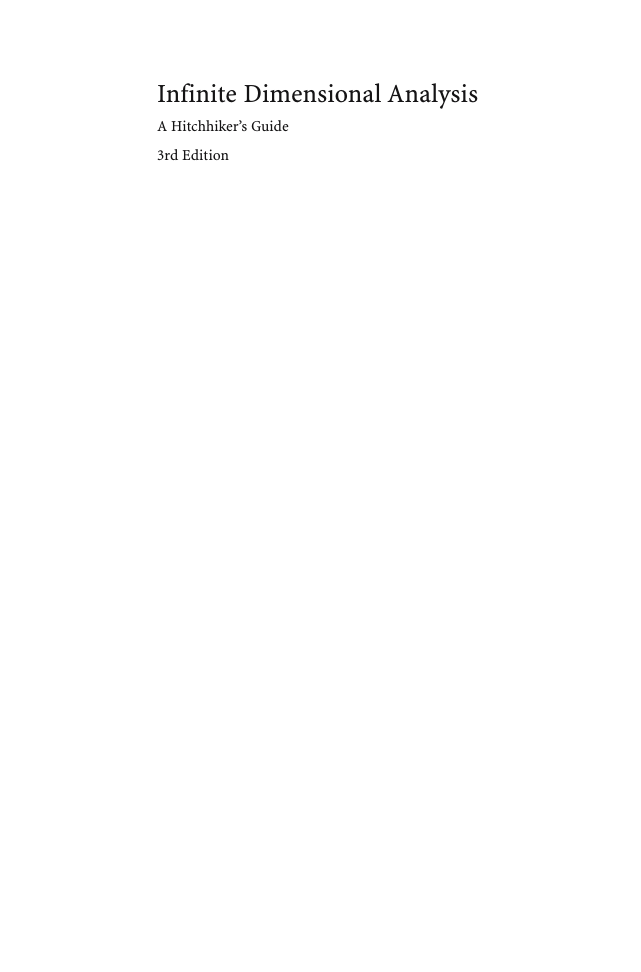
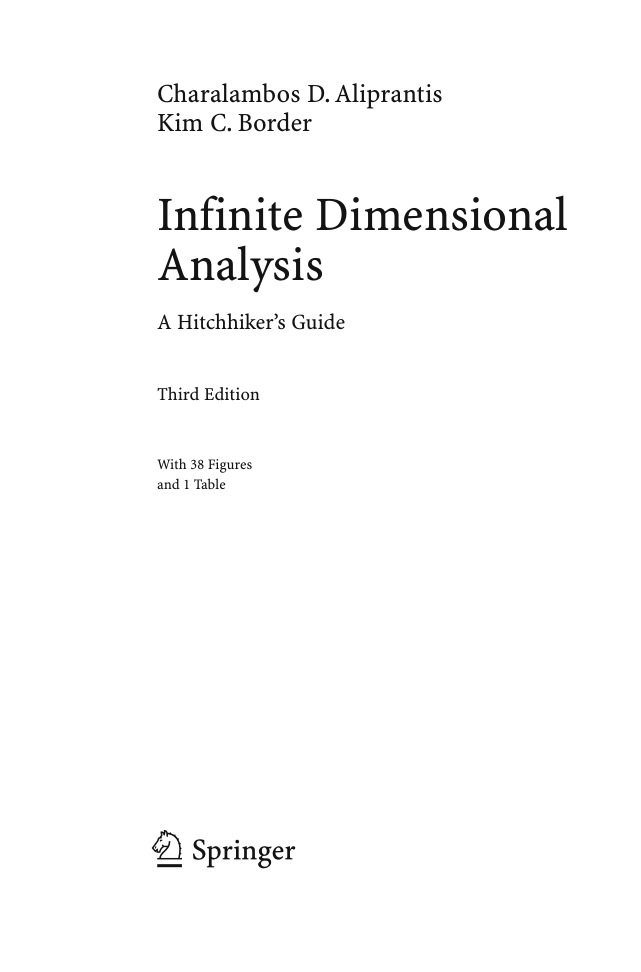


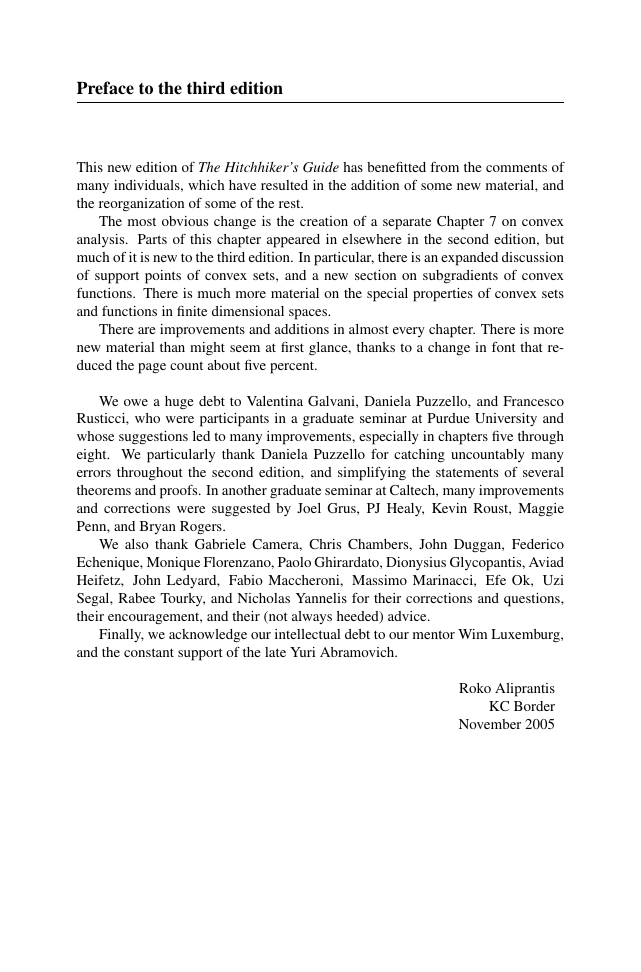
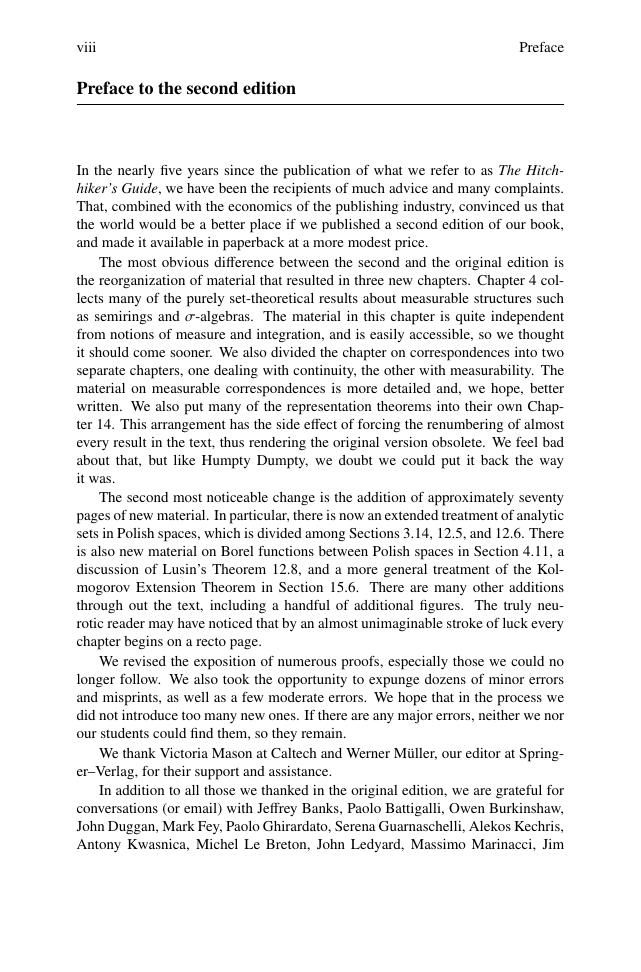
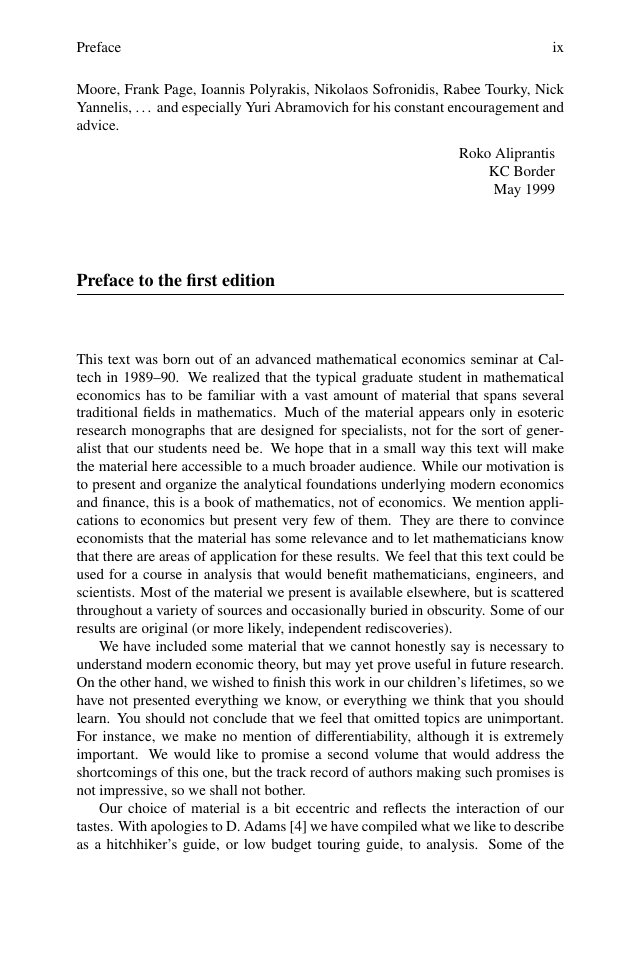
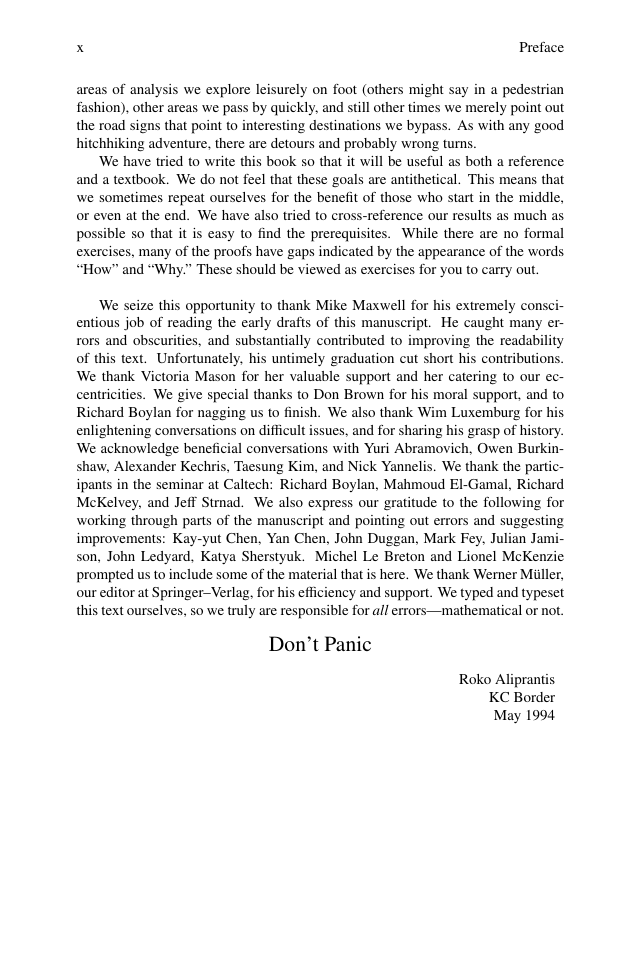








 2023年江西萍乡中考道德与法治真题及答案.doc
2023年江西萍乡中考道德与法治真题及答案.doc 2012年重庆南川中考生物真题及答案.doc
2012年重庆南川中考生物真题及答案.doc 2013年江西师范大学地理学综合及文艺理论基础考研真题.doc
2013年江西师范大学地理学综合及文艺理论基础考研真题.doc 2020年四川甘孜小升初语文真题及答案I卷.doc
2020年四川甘孜小升初语文真题及答案I卷.doc 2020年注册岩土工程师专业基础考试真题及答案.doc
2020年注册岩土工程师专业基础考试真题及答案.doc 2023-2024学年福建省厦门市九年级上学期数学月考试题及答案.doc
2023-2024学年福建省厦门市九年级上学期数学月考试题及答案.doc 2021-2022学年辽宁省沈阳市大东区九年级上学期语文期末试题及答案.doc
2021-2022学年辽宁省沈阳市大东区九年级上学期语文期末试题及答案.doc 2022-2023学年北京东城区初三第一学期物理期末试卷及答案.doc
2022-2023学年北京东城区初三第一学期物理期末试卷及答案.doc 2018上半年江西教师资格初中地理学科知识与教学能力真题及答案.doc
2018上半年江西教师资格初中地理学科知识与教学能力真题及答案.doc 2012年河北国家公务员申论考试真题及答案-省级.doc
2012年河北国家公务员申论考试真题及答案-省级.doc 2020-2021学年江苏省扬州市江都区邵樊片九年级上学期数学第一次质量检测试题及答案.doc
2020-2021学年江苏省扬州市江都区邵樊片九年级上学期数学第一次质量检测试题及答案.doc 2022下半年黑龙江教师资格证中学综合素质真题及答案.doc
2022下半年黑龙江教师资格证中学综合素质真题及答案.doc